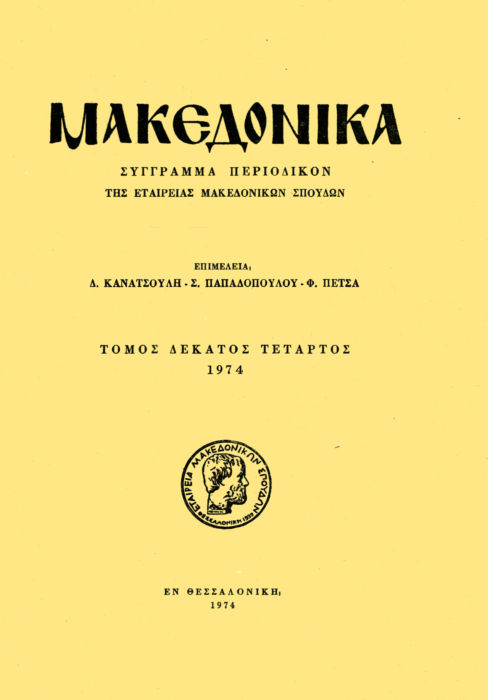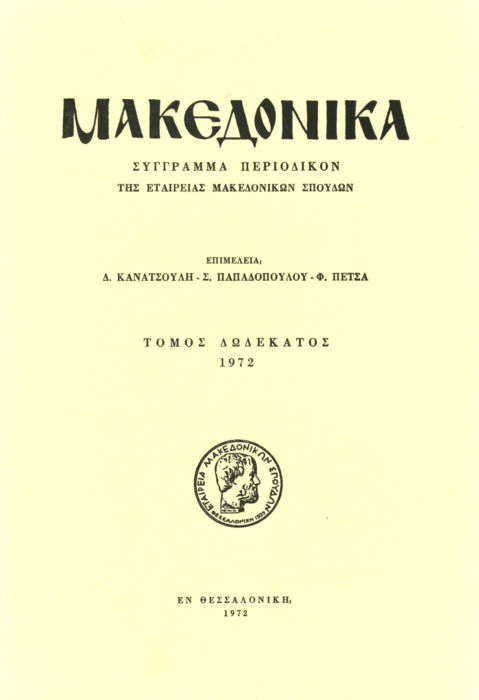The individual grants of the Roman citizenship (civitas Romana) and its expansion in the Roman province of Macedonia (I. The case of Thessaloniki, capital of the province)
Abstract
In the frame of a wider study on the subject of the grant of the Roman citizenship and the expansion of the Roman civil law in the Roman provinces of the Balkan Peninsula, we publish here the results of our research concerning the city of Thessaloniki, capital of the Roman province of Macedonia and seat of the provincial Roman magistrates. Meanwhile we have already published the results of our research concerning the Roman province of Thrace (Dim. C. Samsaris, Research on the history, topography and cults of the Roman provinces of Macedonia and Thrace, V. The policy of the Roman Emperors concerning the Roman citizenship and the expansion of the Roman civil law in the Roman province of Thrace, Thessaloniki 1984, pp. 131 sqq.) Our study on the consequences and application of the constitutio Antoniniana in the Roman province of Macedonia, is going to be published in the near future.
After having discussed the various problems on the method for identifying the peregrinos who became Roman citizens, we came to the conclusion that we can classify them into three groups, according to the reliability of their identification through the inscriptions.
The first group consists of: 1) those bearing the gentilicia of Emperors (302 persons): 71 Aelii, 12 M. Aurelii, 92 Iulii, 67 Claudii, 9 Ulpii, 5 Septimii and 46 Flavi7; 2) those bearing the gentilicia belonging to Roman magistrates of the Macedonia province; those are 29 persons: Acilii, Cas- sii, Minicii, Novii, Scribonii, Fabii and Fontei. In the second group we can classify 74 persons with a gentilicium common among the Roman magistrates of the Macedonia province and the Italian traders (negotiatores): Aemilii, Annii, Antonii, Arruntii, Baebii, Geminii, Iunii, Cornelii, Clodii, Licirtnii, Lollii, Lucilii, Marcii, Memmii, Octavii, Pontii, Sextii, Tulii, Vettii. Finally in the third group we can count 47 persons bearing a gentilicium to be found in the neighbouring Roman provinces (Achaia, Asia, Thrace) or a rare gentilicium of unknown origin: Aupronii, Apreicii, Arnobii, Cominii, Domittii, Lardi, Valerli, Vettidii etc.
The article ends with general conclusions and verifications. Thus we establish that the peregrini of Thessaloniki who had become Roman citizens reach the considerable number of 452: 331 persons (73,2%) of the first group, 74 persons (16,4%) of the sencond group and 47 persons (10,4%) of the third. We also find out that on a whole of 452 persons who received the Roman citizenship 302 (66,8%) are bearing the gentilicium of the Emperors, 103 (22,8%) a gentilicium common to Roman magistrates of the Macedonia province and 47 persons (10,4%) are bearing a gentilicium of unknown origin or a gentilicium to be found among the magistrates of the neighbouring Roman provinces. Also taking into consideration the chronological facts, we come to the conclusion that the grant of the Roman citizenship to the peregrinos of Thessaloniki begins early in the 1st c BC and is growing during the period of Iulii-Claudii dynasty. During the following dynasties the naturalizations’ rythm is varying. Thus we have the highest percentage in the period of the Antonins with a peak during the reign of the emperor Adrien, known for his philhellenic policy.
With regard to the social dimensions of the naturalizations’ phenomenon, we notice that a high percentage of the 40% affects members of the local aristocracy. This indicates that this particular social class was the foundation upon which the Roman power was based.
Finally our research has proved that: 1) the expansion of the Roman civil law in Thessaloniki did not result in the Romanization of its inhabitants; 2) this city, as capital of the Roman province of Macedonia, was especially favoured by the Roman policy concerning the individual grants of the Roman citizenship.
Article Details
- How to Cite
-
Σαμσάρης Δ. Κ. (1987). The individual grants of the Roman citizenship (civitas Romana) and its expansion in the Roman province of Macedonia (I. The case of Thessaloniki, capital of the province). Makedonika, 26, 308–353. https://doi.org/10.12681/makedonika.1084
- Section
- Articles

This work is licensed under a Creative Commons Attribution-NonCommercial-ShareAlike 4.0 International License.
Authors who publish with this journal agree to the following terms:
- Authors retain copyright and grant the journal right of first publication with the work simultaneously licensed under a Creative Commons Attribution Non-Commercial License that allows others to share the work with an acknowledgement of the work's authorship and initial publication in this journal.
- Authors are able to enter into separate, additional contractual arrangements for the non-exclusive distribution of the journal's published version of the work (e.g. post it to an institutional repository or publish it in a book), with an acknowledgement of its initial publication in this journal.
- Authors are permitted and encouraged to post their work online (preferably in institutional repositories or on their website) prior to and during the submission process, as it can lead to productive exchanges, as well as earlier and greater citation of published work (See The Effect of Open Access).






